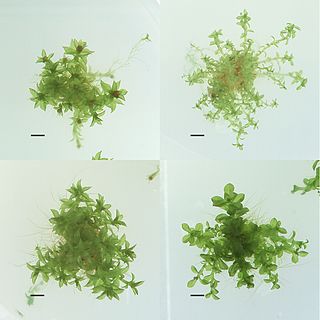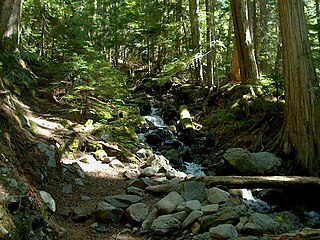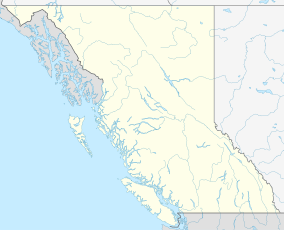
The reindeer or caribou is a species of deer with circumpolar distribution, native to Arctic, subarctic, tundra, boreal, and mountainous regions of Northern Europe, Siberia, and North America. It is the only representative of the genus Rangifer. More recent studies suggest the splitting of reindeer and caribou into six distinct species over their range.

In evolutionary ecology, an ecotype, sometimes called ecospecies, describes a genetically distinct geographic variety, population, or race within a species, which is genotypically adapted to specific environmental conditions.

The migratory woodland caribou refers to two herds of Rangifer tarandus that are included in the migratory woodland ecotype of the subspecies Rangifer tarandus caribou or woodland caribou that live in Nunavik, Quebec, and Labrador: the Leaf River caribou herd (LRCH) and the George River caribou herd (GRCH) south of Ungava Bay. Rangifer tarandus caribou is further divided into three ecotypes: the migratory barren-ground ecotype, the mountain ecotype or woodland (montane) and the forest-dwelling ecotype. According to researchers, the "George River herd which morphologically and genetically belong to the woodland caribou subspecies, at one time represented the largest caribou herd in the world and migrating thousands of kilometers from boreal forest to open tundra, where most females calve within a three-week period. This behaviour is more like barren-ground caribou subspecies." They argued that "understanding ecotype in relation to existing ecological constraints and releases may be more important than the taxonomic relationships between populations." The migratory George River caribou herd travel thousands of kilometres moving from wintering grounds to calving grounds near the Inuit hamlet of Kangiqsualujjuaq, Nunavik. In Nunavik and Labrador, the caribou population varies considerably with their numbers peaking in the later decades of each of the 18th, 19th and 20th centuries. In 1984, about 10,000 caribou of the George River herd drowned during their bi-annual crossing of the Caniapiscau River during the James Bay Hydro Project flooding operation. The most recent decline at the turn of the 20th century caused much hardship for the Inuit and Cree communities of Nunavik, who hunt them for subsistence.

The Porcupine caribou(Rangifer tarandus groenlandicus) is a herd or ecotype of barren-ground caribou, the subspecies of the reindeer or caribou found in Alaska, United States, and Yukon and the Northwest Territories, Canada.
Pink Mountain may refer to an unincorporated community on the Alaska Highway, a nearby mountain, or the hunting guiding territory west of the mountain.
Spatsizi Plateau Wilderness Provincial Park is located in the northern portion of British Columbia, Canada, approximately 698, 659 hectares and encompasses the Spatsizi River and Gladys Lake Ecological Reserve. The park is a designated protected area that is intended for the conservation and research on caribou, grizzly bears, fish, and other wildlife species populations. Before the provincial park's establishment in 1975, the area was a historical hunting ground for local Indigenous communities like the Tahltan First Nations.It is the second largest provincial park in British Columbia.
Tweedsmuir North Provincial Park and Protected Area is a provincial park in British Columbia, Canada, which along with Tweedsmuir South Provincial Park and Entiako Provincial Park were once part of Tweedsmuir Provincial Park, then B. C.'s largest park, 9,810 square kilometres (3,790 sq mi) located in the Coast Range.
Tweedsmuir South Provincial Park is a provincial park covering parts of the eastern Kitimat Ranges, northern Pacific Ranges, and the Rainbow Range in British Columbia, Canada. It was established on May 21, 1938 in the western interior of the province, to protect its important natural features. The park hosts a variety of recreation activities for visitors. This park encompasses a range of diverse species in this park including bears, moose, and various fish. There are also a few at risk species in this park.

British Columbia mainland coastal forests is a temperate coniferous forest ecoregion the Pacific coast of North America, as defined by the World Wildlife Fund (WWF) categorization system.

The Peary caribou is a subspecies of caribou found in the High Arctic islands of Nunavut and the Northwest Territories in Canada. They are the smallest of the North American caribou, with the females weighing an average of 60 kg (130 lb) and the males 110 kg (240 lb). In length the females average 1.4 m and the males 1.7 m.

The barren-ground caribou is a subspecies of the reindeer that is found in the Canadian territories of Nunavut and the Northwest Territories, in northern Alaska and in south-western, Greenland. It includes the Porcupine caribou of Yukon and Alaska. The barren-ground caribou is a medium-sized caribou, smaller and lighter-colored than the boreal woodland caribou, with the females weighing around 90 kg (200 lb) and the males around 150 kg (330 lb). However, on some of the smaller islands, the average weight may be less. The large migratory herds of barren-ground caribou take their names from the traditional calving grounds, such as the Ahiak herd, the Baffin Island herds, the Bathurst herd, the Beverly herd, the Bluenose East herd, the Bluenose West herd, the Porcupine herd and the Qamanirjuaq herd.

The Finnish forest reindeer(Rangifer fennicus fennicus, also known as Eurasian or European forest reindeer is a rare subspecies of the reindeer native to Finland and northwestern Russia. They are found primarily in Russian Karelia and the provinces of North Karelia, Savonia and Kainuu in Finland, though some range into central south Finland. They are distinct from the semi-domesticated mountain reindeer in their larger size, longer legs and preference for dense boreal forest habitat, where they are rarely seen by humans, over the open tundra. The Finnish herd migrates seasonally back and forth across the long Russo-Finnish border.

The Muskwa-Slave Lake forests ecoregion covers Canadian taiga in northwestern Alberta, northeastern British Columbia and a large portion of the southwestern Northwest Territories around the Mackenzie River valley and the Great Slave Lake.
The Wildlife Conservation Society Canada, based in Toronto, Ontario, is the Canadian affiliate of the Wildlife Conservation Society International (WCS), incorporated as a conservation organization in Canada in July 2004. WCS Canada currently runs conservation projects across six key regions in Canada led by its staff of field-based scientists.

The boreal woodland caribou, also known as Eastern woodland caribou, boreal forest caribou and forest-dwelling caribou, is a North American subspecies of reindeer found primarily in Canada with small populations in the United States. Unlike the Porcupine caribou and barren-ground caribou, boreal woodland caribou are primarily sedentary.

Dolphin and Union Caribou, Dolphin and Union caribou herd, Dolphin-Union, locally known as Island Caribou, are a migratory population of barren-ground caribou, Rangifer tarandus groenlandicus, that occupy Victoria Island in the Canadian Arctic Archipelago and the nearby mainland. They are endemic to Canada. They migrate across the Dolphin and Union Strait from their summer grazing on Victoria Island to their winter grazing area on the Nunavut-Northwest Territories mainland in Canada. It is unusual for North American caribou to seasonally cross sea ice and the only other caribou to do so are the Peary caribou who are smaller in size and population. They were listed as Endangered by Committee on the Status of Endangered Wildlife in Canada (COSEWIC) since November 2017.
Caribou herds in Canada are discrete populations of seven subspecies that are represented in Canada. Caribou can be found from the High Arctic region south to the boreal forest and Rocky Mountains and from the east to the west coasts.
Boreal woodland caribou(Rangifer tarandus caribou) are a species of caribou and subspecies of North American reindeer. Boreal woodland caribou are also known as southern mountain caribou, woodland caribou, and forest-dwelling caribou. Mountain caribou are uniquely adapted to live in old-growth forests. The mountain caribou diet consists of tree-dwelling lichens predominantly. They are unique in this aspect as in the far northern regions of their habitat zones, the snowpack is shallow enough that the boreal woodland caribou can paw through the snow to eat the ground-dwelling lichens. In the inland Pacific Northwest Rainforests of eastern British Columbia, where the snowpack can reach upwards of five meters, the mountain caribou rely predominantly on the tree-dwelling lichens such as Bryoria spp. and Alectoria spp., hanging above the snowpack. As a result, these mountain caribou are reliant upon the old growth forests, which have been logged for centuries and continue to dwindle.

The reindeer is a widespread and numerous species in the northern Holarctic, being present in both tundra and taiga. Originally, the reindeer was found in Scandinavia, eastern Europe, Russia, Mongolia, and northern China north of the 50th latitude. In North America, it was found in Canada, Alaska, and the northern contiguous USA from Washington to Maine. In the 19th century, it was apparently still present in southern Idaho. It also occurred naturally on Sakhalin, Greenland, and probably even in historical times in Ireland.

The Réserve faunique des Chic-Chocs is a wildlife reserve of Quebec located in east of Parc national de la Gaspésie, in the administrative region of Gaspésie–Îles-de-la-Madeleine, in Quebec, Canada.













